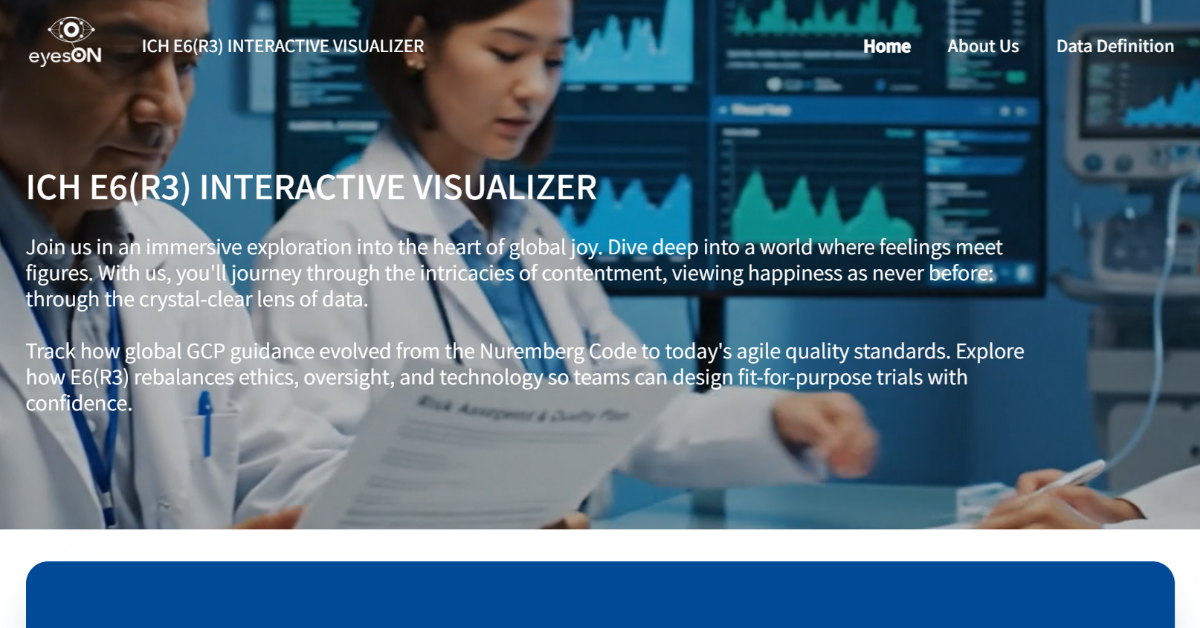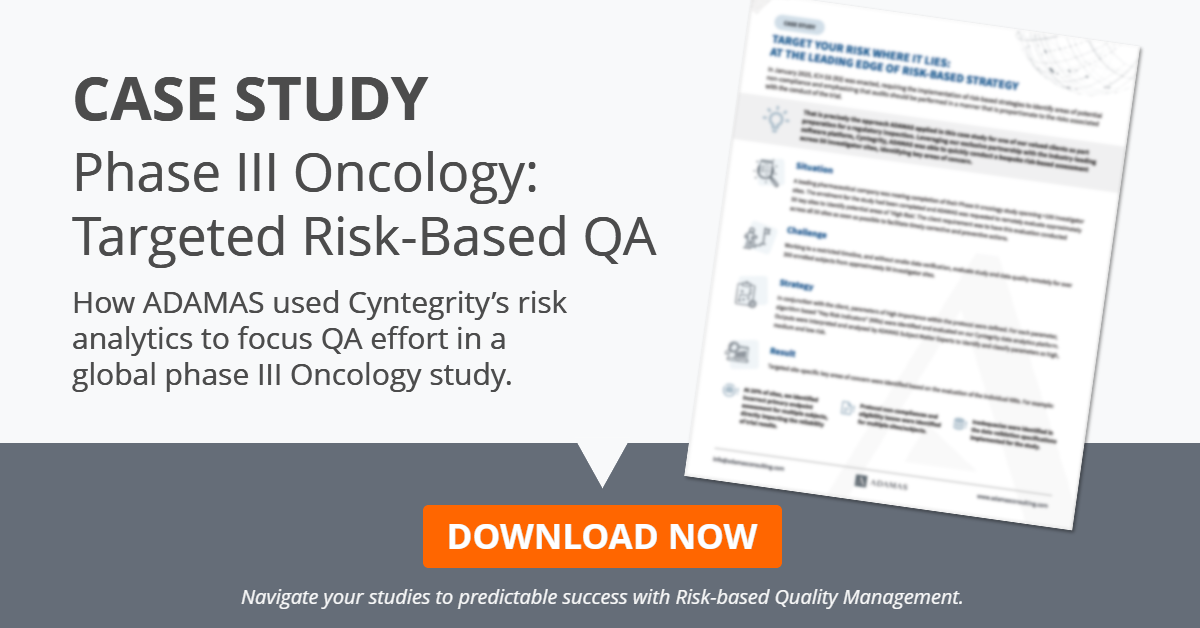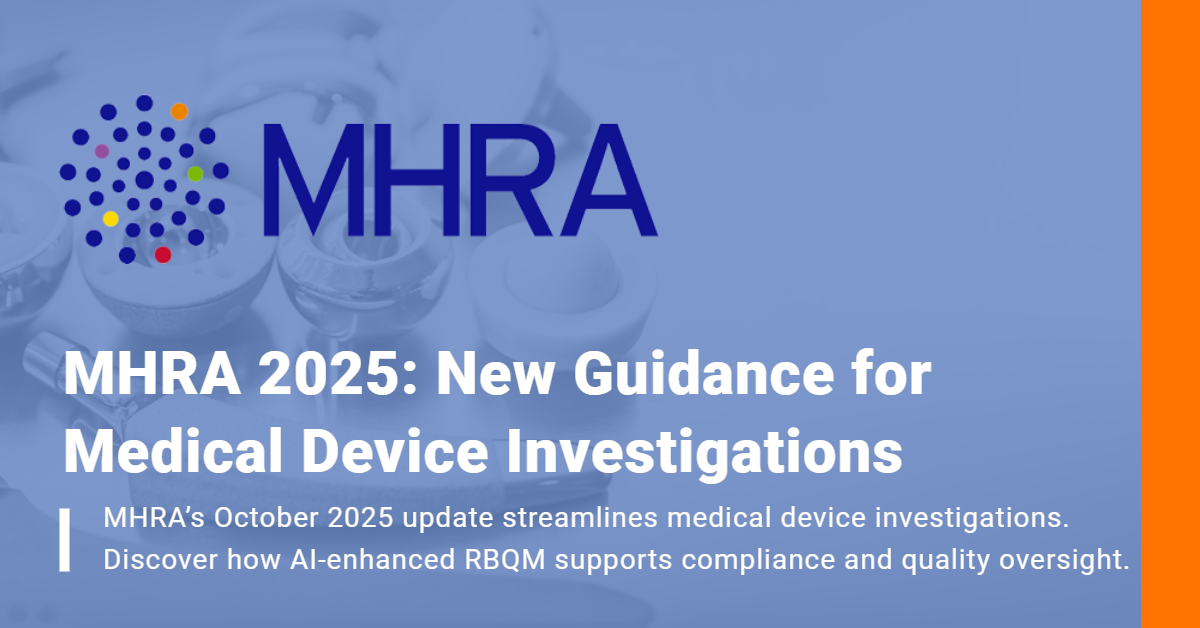Download your Key Risk Indicator (KRI) Infographic

9 Pager Infographic on KRIs (white and black version available)
The infographic will guide you through:
What is risk?
There is a fairly broad consensus to consider risk as the likelihood of a potential hazard occurring and resulting in harm to the trial subjects and/or to the reliability of the results. The OECD defined three major components of risk:
- Risk to patients’ rights
- Risk to patients’ physical integrity and safety
- Risk to data integrity and public health
What do KRIs do?
In general sense, key risk indicators are critical predictors of unfavorable events that can adversely impact clinical trial conduct. Independently or in conjunction with other risk environment-related data, key risk indicators monitor changes in the levels of risk exposure and contribute to the early warning signs that enable clinical study teams to report risks, prevent crises and mitigate them in time.
Simply said, KRIs facilitate the monitoring and control of risk. Basically, a risk indicator can be any metric used to identify your risk exposure over time. They become KRIs when they track an especially important risk or do so especially well because of their predictive value. It’s ideal if they do both.
Developing relevant and effective KRIs requires a deep understanding of your clinical research objectives and risk-related events that might affect the achievement of your objectives.
What are effective KRIs?
Effective key risk indicators are designed to be:
- Relevant; a KRI helps identify, quantify, monitor or manage a clinical risk that is directly associated with key study objectives, or key performance indicators (KPIs).
- Measurable; a KRI can be quantified as e.g. a number, percentage, etc., is reasonably precise, comparable over time, and is meaningful without interpretation.
- Predictive; a key risk indicator can predict future issues that study teams can proactively act on.
- Easy to monitor; a KRI is simple and cost-effective to collect, analyze and report on.
- Auditable; key risk indicators can be verified, i.e. the way they were sourced, aggregated and reported on.
- Comparable; benchmarking KRIs, both internally and to industry standards, is an important step in the validation of their corresponding thresholds.
How many KRIs should you have?
Too much data can be overwhelming. Too little, and you’re not going to gain any insight or could be missing critical risk indicators. There is no right or wrong answer for how many risk indicators you should have. However, it might be helpful to consider the following aspects when selecting your set of KRIs:
- number and nature of the key risks identified
- availability of the data needed for the KRIs
- cost to extract the data
- intended audience
Each clinical organization or study has a number of different factors that come into play – like objectives, culture, indications, therapies, processes, and other activities—that will define which KRIs should be monitored.
What is KRI Wiki?
 Cyntegrity’s KRI Wiki is an editable, growing library of previously used or researched illustrative measurements of risks that can be installed and tracked to lower the risk profile of your clinical research process. Currently, KRI Wiki holds over 280 specified KRIs, which can be filtered for categories such as risk type and risk event.
Cyntegrity’s KRI Wiki is an editable, growing library of previously used or researched illustrative measurements of risks that can be installed and tracked to lower the risk profile of your clinical research process. Currently, KRI Wiki holds over 280 specified KRIs, which can be filtered for categories such as risk type and risk event.
The KRI library can be used as a starting point to determine what gaps exist in your current risk management activities. When designing a clinical trial, study teams often do not have a frame of reference to begin picking the most useful and relevant KRIs for their processes. By making use of the comprehensive KRI Wiki you can better assess what areas of clinical trial conduct pose a risk to their specific operations.
Learn more about KRI Wiki:
- Dr Nimita Limaye: KRI Wiki is a Path Breaking Initiative
- Data Integration – A Valid Concern or a Convenient Excuse?
Sustainable KRIs: measure, monitor, and communicate
Carefully designed and selected KRIs to help you prevent risks and exploit the opportunities they offer. You can use them as a powerful management tool to improve risk awareness and the execution of clinical research objectives.
KRIs are not static and need to be monitored and updated as your clinical study objectives change and evolve.
Safeguarding your clinical operations from organizational, reputational and other risks, requires periodic and regular reviews of key risk indicators. While most clinical study teams monitor KRIs that have developed over time, it is essential for these to be regularly evaluated for effectiveness and continuously monitored to highlight potential risks. Over time, they must be extended or substituted with new KRIs to meet the dynamic circumstances the moment newer risks emerge and the older KRIs seem no longer applicable.
Selecting and building alignment around which KRIs are right for your clinical study is the first step. Developing a program for sustainable, durable, and accurate measurement—as well as ongoing communication—of KRIs is the second step. In order to create a solid, sustainable clinical trial program that will deliver consistent value indefinitely, you need to take a risk-based approach that considers people, process, and technology.






